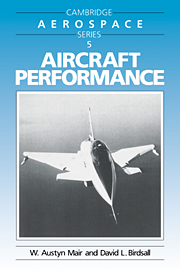Book contents
- Frontmatter
- Contents
- Preface
- Introduction
- 1 Aerodynamic foundations
- 2 Basic flight theory
- 3 Drag equations
- 4 Climbing performance
- 5 Power plants
- 6 Take-off and landing performance
- 7 Fuel consumption, range and endurance
- 8 Turning performance
- 9 Vectored thrust
- 10 Transonic and supersonic flight
- Appendixes
- References
- Index
6 - Take-off and landing performance
Published online by Cambridge University Press: 02 December 2009
- Frontmatter
- Contents
- Preface
- Introduction
- 1 Aerodynamic foundations
- 2 Basic flight theory
- 3 Drag equations
- 4 Climbing performance
- 5 Power plants
- 6 Take-off and landing performance
- 7 Fuel consumption, range and endurance
- 8 Turning performance
- 9 Vectored thrust
- 10 Transonic and supersonic flight
- Appendixes
- References
- Index
Summary
In most of the traditional areas of performance studies the central effort is directed towards a refinement of aerodynamic design in order to ensure efficiency of flight. In studying take-off and landing performance attention is directed more to the capacity of the engines to accelerate the aircraft in a condition of high drag coefficient when the available distance is limited, and to the braking capacity during landing for the same reason. There is limited opportunity for refinement of aerodynamics, although in recent years some progress has been made in reducing the drag of an aircraft in the take-off configuration. In the crucial periods close to lift-off and touchdown the behaviour of the aircraft is strongly dependent on piloting technique and there is a need to define standard procedures for these two manoeuvres, based on reference speeds which are used in defining the criteria laid down in airworthiness regulations for safe operations. The lengths of the ground run and the airborne sector in a take-off are both strongly influenced by engine performance and the effective drag polar, whereas in landing there is an airborne sector which is critically dependent on piloting technique to produce a tangential flare to touchdown, followed by a ground run which depends on braking capacity.
The take-off performance cannot be defined so simply when allowance is made for failure of an engine and this chapter considers not only the ideal performance when the manoeuvre proceeds as planned, but also the reduced performance obtained after an engine failure.
- Type
- Chapter
- Information
- Aircraft Performance , pp. 119 - 161Publisher: Cambridge University PressPrint publication year: 1992
- 1
- Cited by



